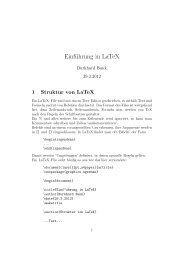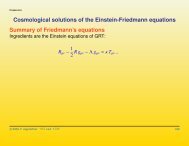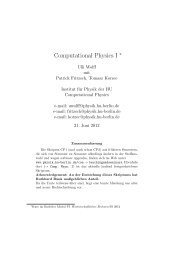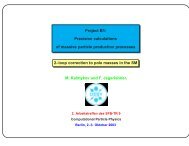Preprint[pdf] - HU Berlin
Preprint[pdf] - HU Berlin
Preprint[pdf] - HU Berlin
Create successful ePaper yourself
Turn your PDF publications into a flip-book with our unique Google optimized e-Paper software.
For a particle with spin the magnetic moment is intrinsic and obtained by replacing the the angular<br />
momentum operator � L by the spin operator<br />
�S = �σ<br />
2<br />
, (4)<br />
where σi (i = 1, 2, 3) are the Pauli spin matrices. Thus, generalizing the classical form (1) of the orbital<br />
magnetic moment, one writes<br />
�µm = g Q µ0<br />
�σ<br />
2 , de<br />
�<br />
�σ<br />
= η Q µ0 , (5)<br />
2<br />
where µ0 = e/2m, Q is the electrical charge in units of e, Q = −1 for the leptons (ℓ = e, µ, τ), Q = +1 for<br />
the antileptons and m is the mass. The equations define the gyromagnetic ratio g (g-factor) and its electric<br />
pendant η, respectively, quantities exhibiting important dynamical information about the leptons as we will<br />
see later. The deviation from the Dirac value gℓ/2 = 1, obtained at the classical level, is<br />
aℓ ≡ gℓ − 2<br />
2<br />
the famous anomalous magnetic moment and aµ is the quantity in the focus of this review.<br />
The magnetic interaction term gives rise to the well known Zeeman effect: level splitting seen in atomic<br />
spectra. If spin is involved one calls it anomalous Zeeman effect. The latter obviously is suitable to study<br />
the magnetic moment of the electron by investigating atomic spectra in magnetic fields.<br />
The most important condition for the anomalous magnetic moment to be a useful monitor for testing<br />
a theory is its unambiguous predictability within that theory. The predictability crucially depends on the<br />
following properties of the theory:<br />
– it must be a local relativistic quantum field theory and<br />
– it must be renormalizable.<br />
This implies that g − 2 vanishes at tree level and cannot be an independently adjustable parameter in any<br />
renormalizable QFT. This in turn implies that for a given theory [model] g−2 is an unambiguously calculable<br />
quantity and the predicted value can be confronted with experiments. Its model dependence makes aµ a<br />
good monitor for the detection of new physics contributions. The key point is that g −2 can be both precisely<br />
predicted as well as experimentally measured with very high accuracy. By confronting precise theoretical<br />
predictions with precisely measured experimental data it is possible to subject the theory to very stringent<br />
tests and to find its possible limitations.<br />
The anomalous magnetic moment of a lepton is a dimensionless quantity, a number, which in QED may<br />
be computed order by order as an expansion in the fine structure constant α. Beyond QED, in the SM or<br />
extensions of it, weak and strong coupling contributions are calculable. As a matter of fact, the interaction<br />
of the lepton with photons or other particles induces an effective interaction term<br />
δL AMM<br />
eff<br />
= −δg<br />
2<br />
e �<br />
¯ψL(x) σ<br />
4m<br />
µν Fµν(x) ψR(x) + ¯ ψR(x) σ µν Fµν(x) ψL(x) �<br />
where ψL and ψR are Dirac fields of negative (left–handed L) and positive (right–handed R) chirality and<br />
Fµν = ∂µAν − ∂νAµ is the electromagnetic field strength tensor. It corresponds to a dimension 5 operator<br />
and since a renormalizable theory is constrained to exhibit terms of dimension 4 or less only, such a term<br />
must be absent for any fermion in any renormalizable theory at tree level.<br />
The dipole moments are very interesting quantities for the study of the discrete symmetries. A basic<br />
consequence of any relativistic local QFT is charge conjugation C, the particle–antiparticle duality [5] or<br />
crossing property, which implies in the first place that particles and antiparticles have identical masses and<br />
spins. In fact, charge conjugation turned out not to be a universal symmetry in nature. Since an antiparticle<br />
may be considered as a particle propagating backwards in time, charge conjugation has to be considered<br />
together with time-reversal T (time-reflection), which in a relativistic theory has to go together with parity<br />
P (space-reflection). The CPT theorem says: the product of the three discrete transformations, C, P and<br />
T, taken in any order, is a symmetry of any relativistic local QFT. Actually, in contrast to the individual<br />
4<br />
(6)<br />
(7)


![Preprint[pdf] - HU Berlin](https://img.yumpu.com/3833433/4/500x640/preprintpdf-hu-berlin.jpg)




